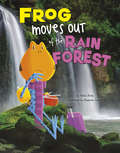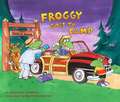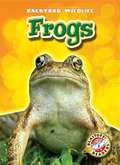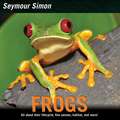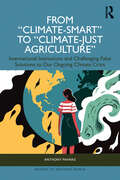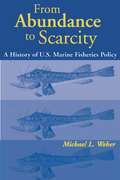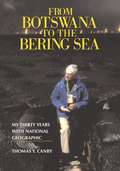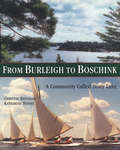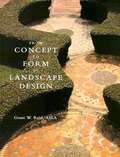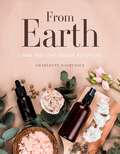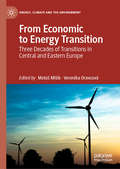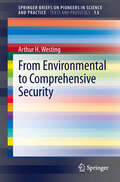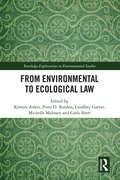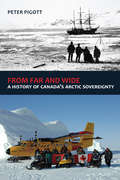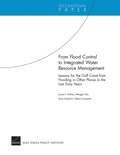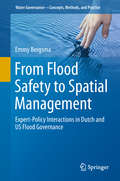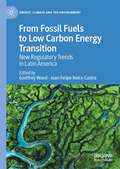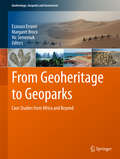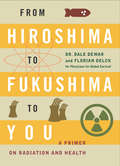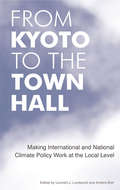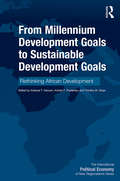- Table View
- List View
Frog Moves Out of the Rain Forest (Habitat Hunter)
by Nikki PottsFrog is bored with its habitat! Follow Frog as it tries out different places to live. Which habitat will make the best home for Frog?
Froggy Goes to Camp
by Jonathan LondonLook out, Camp Run-A-Muck! Here comes Froggy... Froggy's off to camp--and Camp Run-A-Muck will never be the same! Froggy packs a lot into one week: hikes and archery lessons, K.P. and food fights, scary stories and funny songs around the campfire. But only Froggy could also manage to lose his trunks during swim class and overturn his kayak with the camp director in it. Lovable, bumbling Froggy will keep his many fans laughing with his latest antics.
Frogs
by Emily GreenFrogs are powerful jumpers. They have been known to leap distances over 30 feet! Young learners will discover the physical characteristics of frogs, where they live, and what they eat to get the energy to leap.
Frogs (Seymour Simon Science Ser.)
by Seymour SimonAward-winning science writer Seymour Simon takes readers on a journey through a frog's life cycle, from egg to tadpole to grown frog in this engaging nonfiction picture book. Readers will learn about the different types of frogs and toads from all over the world! Where do frogs live? How do frogs eat and drink? How far can they jump? Find out and more in this beautiful picture book ideal for young scientists and animal-lovers filled with fascinating facts, stunning full-color photographs, and an underlying message of ecological preservation.. This book includes an author's note, a glossary, and an index. An excellent choice for classrooms and homeschooling, Frogs supports the Common Core State Standards.
From "Climate-Smart" to "Climate-Just Agriculture”: International Institutions and Challenging False Solutions to our Ongoing Climate Crisis (Bridges to Another World)
by Anthony PahnkeCombining innovative social theory with ongoing policy discussions on climate change, this book analyzes past and present efforts at challenging global poverty through reforming the dynamics of worldwide agricultural production.Focusing on the efforts of the World Bank and CGIAR research centers, particularly through research and projects that have been launched by the International Maize and Wheat Improvement Center (CIMMYT) and the International Food Policy Research Institute (IFPRI), “Climate-Smart” to “Climate-Just” exposes how neoliberal principles of limited government and individual entrepreneurship have expanded through the development of “Climate-Smart Agriculture.” At the same, an alternative – “Climate-Just Agriculture” – is becoming possible as rightwing populists have disrupted international free trade orthodoxy, and social movement demands for food sovereignty gain traction in key international spaces.As Pahnke explains in this innovative account, “Climate-Just Agriculture” includes structural changes to free trade agreements that would build from local and regional food systems to make them resilient in the face of the adverse effects of climate change. This resiliency, moreover, allows marginalized groups the capacity to create and participate in markets that allow for greater self-sufficiency to push back on colonialism and imperialism.Written in a clear and accessible style, this book will be essential reading for students and scholars of sociology, environmental studies, and politics, as well as for policymakers and professionals involved in climate change policy and the agriculture and food industry.
From Abundance to Scarcity: A History Of U.S. Marine Fisheries Policy
by Michael L. WeberThe management of coastal and ocean fisheries is highly contentious. Industry interests focus on maximizing catches while conservationists and marine scientists have become increasingly concerned about dramatic declines in fish stocks and the health of ecosystems. Besides attempting to mediate among these interests, government agencies have pursued their own agendas, which have often lagged behind shifts in scientific understanding and public attitudes about the productivity of the oceans and uses of marine wildlife.From Abundance to Scarcity examines the evolution of US fisheries policy and institutions from the late 19th century to the present day, with an emphasis on changes since World War II. Based on archival research and interviews with dozens of key players in marine policymaking, it traces the thinking, legislation, mandates, and people that have shaped the various agencies governing fisheries in the United States. The book discusses the development of federal programs in marine biological sciences and the evolution of scientific understanding about marine wildlife populations; describes the work of federal fisheries programs; considers the response of agencies to factors such as dam-building and coastal development that have led to increased pollution and habitat loss; examines the shifts in understanding and values that underlie major legislation; and examines the evolving relationship between federal agencies, the fishing industry, communities, and nongovernmental conservation organizations.From Abundance to Scarcity sheds light on the sets of interests that have shaped US fisheries policy, lending historical depth to current debates and providing a fuller understanding of current laws and regulations. It offers an insightful overview for professionals involved with fisheries management or the fishing industry, conservationists working on marine issues, and students of marine, environmental, or public policy.
From Apple Trees To Cider, Please!
by Felicia Sanzari Chernesky Julia PattonGrab the wagon, it's a bright autumn day and the trees are full of ripe, red apples! There's an apple festival underway at the farm and lots of work to do making cider. This visit finishes with a cider doughnut and a cup of freshly pressed cider. DELICIOUS! Told in crisp, action-driven thymes from a young child's point of view, From Apple Trees to Cider, Please! is a realistic account of how apple cider is pressed, flavored with the charm and vigor of a harvest celebration.
From Apples to Applesauce (From Farm to Table, First Facts)
by Kristin Thoennes KellerWhere does applesauce come from? Learn how applesauce starts with fresh apples in an apple orchard. Follow along as the apples are taken to a factory and made into applesauce. Before food arrives in your home in neat packages, it travels on an amazing journey. The First Facts From Farm to Table set illustrates how food is processed and manufactured. Hungry readers will visit a farm to discover their favorite treat in its raw state, and then follow the production line as the food is harvested, transported to factories for processing, packaged for distribution, and, finally, sold to the consumer. Illustrative photography, fact-filled texts, and fun features will satisfy young readers' hunger for food knowledge.
From Big Oil to Big Green: Holding the Oil Industry to Account for the Climate Crisis
by Marco GrassoHow Big Oil can transform itself into Big Green through reparation and decarbonization to rectify the harm it has done through fossil fuels. In From Big Oil to Big Green, Marco Grasso examines the responsibility of the oil and gas industry for the climate crisis and develops a moral framework that lays out its duties of reparation and decarbonization to allay the harm it has done. By framing climate change as a moral issue and outlining the industry&’s obligation to tackle it, Grasso shows that Big Oil is a central, yet overlooked, agent of climate ethics and policy. Grasso argues that by indiscriminately flooding the global economy with fossil fuels—while convincing the public that halting climate change is a matter of consumer choice, that fossil fuels are synonymous with energy, and that a decarbonized world would take civilization back to the Stone Age—Big Oil is morally responsible for the climate crisis. He explains that it has managed to avoid being held financially accountable for past harm and that its duty of reparation has never been theoretically developed or justified. With this book, he fills those gaps. After making the moral case for climate reparations and their implementation, Grasso develops Big Oil&’s duty of decarbonization, which entails its transformation into Big Green by phasing out carbon emissions from its processes and, especially, its products.
From Botswana to the Bering Sea: My Thirty Years With National Geographic
by Thomas CanbyNational Geographic has been called a window on the world and a passport to adventure. Each month an estimated forty million people in 190 countries open its pages and are transported to exotic realms that delight the eye and mind. Such widespread renown gives the magazine's writers unmatched access to people and places, as doors that are closed to the rest of the journalistic world open wide. Thomas Y. Canby was a National Geographic writer and science editor from 1961 to 1991, a time during which the Society grew by leaps and bounds and the resources available to staff were seemingly limitless. In From Botswana to the Bering Sea, he gives readers a look at the life of a National Geographic field staffer and an insider's view of the fascinating dynamics within the magazine's offices. Canby's assignments dealt with issues of global concern, and his travels took him to the farthest reaches of the planet. This book allows the reader to share in his experiences -- from a Filipino rice harvest capped by a feast of deep-fried rats, to impoverished villages of Asia and Africa gripped by the world's most widespread famine, to seal hunting and dog sledding with Eskimos in the Canadian high Arctic. Readers match wits with paranoid guardians of the secret Soviet space program, skirt land mines in the flaming oil fields of Kuwait, and dodge death while scuba diving to an archaeological site in a Florida sinkhole. The book also gives insight into the magazine's inner workings: how article subjects are chosen and assigned; how writers interact; how prolonged trips to impossibly remote destinations are planned; how staffers operate in the field. Working for National Geographic has been called "the best job in the world." From Botswana to the Bering Sea describes that unique job, and answers the question Canby and his colleagues are so often asked: "So, what is it like to work for National Geographic?"
From Burleigh to Boschink: A Community Called Stony Lake
by Christie Bentham Katharine HookeFrom Burleigh to Boschink: A Community Called Stony Lake covers over a hundred years of human history, encompassing the Aboriginal Peoples, their presence and influence, early settlement and cottaging activity up to the present time. Family stories, local lore, boats and steamers, recreational opportunities, personalities and environmental concerns are all presented through the writings, the voices and the memories of those who were there and, in some cases, still are. Richly supported by rare photographs and other visuals of Stony Lake, this publication will bring delight to many.
From Concept to Form in Landscape Design
by Grant W. ReidFrom Concept to Form in Landscape Design provides vital, functional techniques that make the transformation easier and more effective.
From Earth
by Charlotte RasmussenCreate your own natural apothecary using readily available ingredients with the easy, step-by-step instructions and straightforward advice in From Earth Inspired by author Charlotte Rasmussen's Scandinavian upbringing and the botanicals she has discovered since moving to Australia, this is a perfect guide for anyone wanting to find a more holistic way of life. Within these pages you will discover expert knowledge tailored to your lifestyle, whether you need moisturizer for dry skin or a decongestant for your child. You will be become confident combining herbs and oils and be inspired to create your own essential oil blends to infuse your home with the perfect ambience. The heart of From Earth is about taking the natural resources provided by our planet and using them to improve your life. Instead of buying products filled with unintelligible chemicals, using this book you will be able to take control of your own skin care, fragrances and home remedies. You will be able to connect with your environment and body, restoring your health and wellbeing with a variety of homemade, naturally sourced recipes.
From Economic to Energy Transition: Three Decades of Transitions in Central and Eastern Europe (Energy, Climate and the Environment)
by Matúš Mišík Veronika OravcováThis book examines energy transition issues within the Central and Eastern European (CEE) region. The European Union is aiming for an almost complete decarbonization of its energy sector by 2050. However, the path towards a carbon-free economy is full of challenges that must be solved by individual EU members. Across 18 chapters, leading researchers explore challenges related to energy transition and analyse individual EU members from Central and Eastern Europe, as well as the region as a whole. To further explore this complex issue, the volume also includes several countries from South East Europe in its analysis. As perspective members, these countries will be important contributors to the EU’s mid- and long-term climate and energy goals. The focus on a variety of issues connected to energy transition and systematic analyses of the different CEE countries make it an ideal reference for anyone with a general interest in the region or European energy transition. It will also be a useful resource for students looking for an accessible overview of the field.
From Environmental to Comprehensive Security
by Arthur H. WestingThis work presents the evolution of the traditional concept of "national security" as military security to additionally embrace "environmental security" and then necessarily also "social (societal) security", thence to be termed "comprehensive human security". It accomplishes this primarily by presenting 11 of the author's own benchmark papers published between 1983 and 2010 (additionally providing bibliographic citations to a further 36 of the author's related publications during that period). The work stresses the importance of transfrontier (regional) cooperation, and also recognizes global overpopulation as a key impediment to achieving comprehensive human security.
From Environmental to Ecological Law (Routledge Explorations in Environmental Studies)
by Kirsten Anker; Peter D. Burdon; Geoffrey Garver; Michelle Maloney; Carla SbertThis book increases the visibility, clarity and understanding of ecological law. Ecological law is emerging as a field of law founded on systems thinking and the need to integrate ecological limits, such as planetary boundaries, into law. Presenting new thinking in the field, this book focuses on problem areas of contemporary law including environmental law, property law, trusts, legal theory and First Nations law and explains how ecological law provides solutions. Written by ecological law experts, it does this by 1) providing an overview of shortcomings of environmental law and other areas of contemporary law, 2) presenting specific examples of these shortcomings, 3) explaining what ecological law is and how it provides solutions to the shortcomings of contemporary law, and 4) showing how society can overcome some key challenges in the transition to ecological law. Drawing on a diverse range of case study examples including Indigenous law, ecological restoration and mining, this volume will be of great interest to students, scholars and policymakers of environmental and ecological law and governance, political science, environmental ethics and ecological and degrowth economics.
From Far and Wide: A History of Canada's Arctic Sovereignty
by Peter PigottIn the early 20th century the Canadian North was a mystery, but the Canadian military stepped in, and this book explores its historic activities in Canada’s Arctic. Is the Canadian North a state of mind or simply the lands and waters above the 60th parallel? In searching for the ill-fated Franklin Expedition in the 19th century, Britain’s Royal Navy mapped and charted most of the Arctic Archipelago. In 1874 Canadian Prime Minister Alexander Mackenzie agreed to take up sovereignty of all the Arctic, if only to keep the United States and Tsarist Russia out. But as the dominion expanded east and west, the North was forgotten. Besides a few industries, its potential was unknown. It was as one Canadian said for later. There wasn’t much need to send police or military expeditions to the North. Not only was there little tribal warfare between the Inuit or First Nations, but there were few white settlers to protect and the forts were mainly trading posts. Thus, in the early 20th century, Canada’s Arctic was less known than Sudan or South Africa. From Far and Wide recounts exclusively the historic activities of the Canadian military in Canada’s North.
From Flood Control to Integrated Water Resource Management
by Debra Knopman Sara Hajiamiri Mengjie Wu James P. KahanThe loss of life and devastation in the Gulf coast region of the United States after the hurricane season of 2005 has led to considerable debate about how to recover from the damage and mitigate damage from future incidents. This document reports the experiences of four major floods since 1948 (two in the United States, one in the Netherlands, and one in China), to draw lessons for the Gulf coast restoration effort.
From Flood Safety to Spatial Management: Expert-Policy Interactions in Dutch and US Flood Governance (Water Governance - Concepts, Methods, and Practice)
by Emmy BergsmaThis book deals with the introduction of a new type of “spatial measures" in flood governance. In contrast to traditional “safety measures" that aim to provide protection against floods by building structural flood defenses such as levees and flood walls, the goal of spatial measures is to reduce the exposure to flood risks by changing the spatial layout of flood-prone areas. By limiting developments and flood-proofing buildings in areas at risk to flooding, investments in structural flood defenses can be circumvented and vulnerabilities reduce. World-wide, spatial measures are gaining attractiveness as a response strategy to increasing flood risks caused by climate change and urbanization. The introduction of spatial measures in flood governance involves more than the simple development of new policies and laws. Research has demonstrated that the implementation of spatial measures can have huge implications for how costs and responsibilities are divided between different levels of governance and between public and private actors, changing the whole organization behind flood governance. Both for the effectiveness and for the legitimacy of spatial flood governance strategies, it is important that these distributive implications are well understood. This book describes the introduction of spatial measures in the context of two very different delta countries: the Netherlands and the United States. In the United States, a spatial flood governance strategy was already developed in de mid-20th century whereas in the Netherlands, a safety paradigm institutionalized over the course of the 20th century and spatial measures have only recently been introduced. By analyzing the science-policy interactions underlying the implementation of spatial measures in both countries, this book shows how under the influence of different types of experts (engineers in the Netherlands and social geographers in the United States) different spatial flood management strategies emerged with different distributive implications, each with its own challenges for effectiveness and legitimacy.
From Fossil Fuels to Low Carbon Energy Transition: New Regulatory Trends in Latin America (Energy, Climate and the Environment)
by Geoffrey Wood Juan Felipe Neira-CastroFocusing on five key themes - hydrocarbons, electricity, mining, social license to operate, and arbitration/dispute resolution- via in-depth country and regional case studies, this book seeks to capture the contrasting and sometimes conflicting trends in energy governance in Latin America as it wrestles with a dependence on fossil fuels whilst shifting toward a low carbon future. Energy transition continues to sit at the centre of the Latin American policy debate as the world continues to push for carbon neutrality by 2050. Latin America is undergoing a renewable energy transition, with substantial reserves (solar, wind, hydro, geothermal) and many countries in the region setting ambitious renewable energy policies, laws, and regulations to address climate change. However, recent initiatives to promote renewables must be placed in context. Historically, Latin America has developed and improved its economic and social standards due primarily to an economy based on the extractive industries and fossil fuels. This places renewables at the crossroads of multiple drivers, as the region seek to ensure security of supply, attract investment, and facilitate a low carbon energy transition.
From Geoheritage to Geoparks
by Ezzoura Errami Margaret Brocx Vic SemeniukThis unique book is dedicated to helping promote geoheritage, geoconservation, and geoparks in Africa and the Middle East. Local, regional, global and thematic case studies including a geoheritage toolkit are used to illustrate the scope and depth of geoheritage and highlight some current geoparks and aspiring candidates in Africa, the Middle East, China , Europe,and Australia. This special issue mainly consists of the proceedings of the First International Conference on Geoparks in Africa and Middle East (FICGAME) held in, El Jadida, Morocco in 2011. The conference, hosted by the Faculty of Sciences of Chouaib Doukkali University, was organized by the African Geoparks Network and the African Association of Women in Geosciences incollaboration with the UNESCO Cairo Office.
From Hiroshima to Fukushima to You: A Primer on Radiation and Health
by Florian Oelck Dale DewarThe bombing of Hiroshima on August 6, 1945, brought radiation to international attention but the exact nature of what had been unleashed was still unclear to most. The 1986 meltdown at the Chernobyl nuclear plant again made headlines with estimates of fatalities ranging from 4000 to almost a million deaths. By the time of the shocking 2011 disaster at the Fukushima nuclear plant social media meant governments and corporations no longer had a monopoly over the release of information, but transparency remains low on the agenda. Meanwhile, few physicians give thought to the delayed health effects of radiation. It has been the bold physician who has challenged the potential overuse of chest X-rays, CT scanning, or PET scans. This book provides clear and accurate information about radiation so that we can all make informed choices. In clear language it offers answers to citizens’ questions: What is radiation? Where do we encounter it? What are the benefits and risks? How do we develop a responsible future around the uses and abuses of radioactivity?
From Kyoto to the Town Hall: Making International and National Climate Policy Work at the Local Level
by Lennart J. Lundqvist Anders BielInternational agreements such as the Kyoto Protocol, EU regulation and country-specific national climate policies offer some hope of addressing climate change. But all too often implementation of these high level objectives is derailed at the sub-national, local and - perhaps most important - individual level, by a variety of structural, policy and perceived barriers that result in a failure of effective action. Drawing on original research from Sweden, a world leader in effective environmental solutions, this volume examines the difficulties of aligning climate policy from international to national and sub-national levels. The authors address the full range of barriers and complexities, including governance structures, the relationship between 'experts' and the public, political feasibility, tax measures, perceptions of 'fairness' and self-interest, and the importance of environmental values. Also covered are the roles and perceptions of organizations and professions, the place of carbon-free technologies (such as wind power), the relationship between national and EU regulations, and the monumental challenge of governing the climate in a bordered and divided world. This volume is a vital source of information for all those seeking to create effective, coordinated responses to the challenge of climate change.
From Me to We: The Five Transformational Commitments Required to Rescue the Planet, Your Organization, and Your Life
by Bob DoppeltIn From Me to We: The Five Transformational Commitments Required to Rescue the Planet, Your Organization, and Your Life, systems change expert Bob Doppelt reveals that most people today live a dream world, controlled by false perceptions and beliefs. The most deeply held illusion is that all organisms on Earth, including each of us, exist as independent entities. At the most fundamental level, the change needed to overcome our misperceptions is a shift from focusing only on "me" – our personal needs and wants – to also prioritizing the broader "we": the many ecological and social relationships each of us are part of, those that make life possible and worthwhile. Research shows that by using the techniques described in this book this shift is possible – and not that difficult to achieve. From Me to We offers five transformational "commitments" that can help you change your perspective and engage in activities that will help resolve today's environmental and social problems. Not coincidentally, making these commitments can improve the quality of your life as well. Bob Doppelt's latest book is a wake-up call to the creed of individualism. He calls for recognition of the laws of interdependence, cause and effect, moral justice, trusteeship, and free will. The book will be essential to all of those interested in how we can create and stimulate a sea change in how to enable the necessary behavioral change we need to deal with the myriad environmental and social pressures consuming the planet.
From Millennium Development Goals to Sustainable Development Goals: Rethinking African Development (The International Political Economy of New Regionalisms Series)
by Timothy M. Shaw Kobena T. Hanson Korbla P. PuplampuMillennium development goals (MDGs) and sustainable development goals (SDGs) have significant implications for global development, in particular for African countries. This book seeks to assist Africa’s policy makers and political leaders, MNCs and NGOs, plus its increasingly heterogeneous media landscape, to understand and better respond or negotiate the evolving development environment of the 21st century. In this collection of nuanced essays, the contributors interrogate the relationship between the MDGs and SDGs in key areas of African development to enhance our understanding and knowledge of the evolving nature of development. They address issues of governance, agriculture, south-south cooperation in a context of foreign aid, natural resource governance and sustainable development, export diversification and economic growth as well as emerging topics such as the internet of things or the sharing economy, climate change, conflict and non-traditional security. The varied, yet interlinked foci present a holistic overview of Africa’s development aspirations, and ability to transform the SDGs’ universal aspirations into local realities. This book will be of use to academics and students in Development Studies, Contemporary African Studies, Political Science, Policy Studies and Geography, and should also appeal to policy makers and development practitioners.
